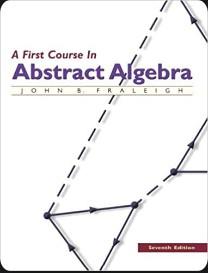Show how all possible G-sets, up to isomorphism (see Exercise 9), can be formed from the group
Question:
Show how all possible G-sets, up to isomorphism (see Exercise 9), can be formed from the group G.
Let Xi for i ∈ I be G-sets for the same group G, and suppose the sets Xi are not necessarily disjoint. Let x'i = {(x, i) |x ∈ Xi} for each i ∈ I. Then the sets X'i are disjoint, and each can still be regarded as a G-setin an obvious way. (The elements of Xi have simply been tagged by i to distinguish them from the elements of Xj for i ≠ j.) The G-set Ui∈I X'i is the disjoint union of the G-sets X;. Using Exercises 14 and 15, show that every G-set is isomorphic to a disjoint union of left coset G-sets, as described in Example 16.7.
Data from in Example 16.7
Let H be a subgroup of G, and let LH be the set of all left cosets of H. Then LH is a G-set, where the action of g ∈ G on the left coset xH is given by g(xH) = (gx)H. Observe that this action is well defined: if yH = xH, then y = x h for some h ∈ H, and g(yH) = (gy)H = (gxh)H = (gx)(hH) = (gx)H = g(xH). A series of exercises shows that every G-set is isomorphic to one that may be formed using these left coset G-sets as building blocks.
Data from Exercise 9
Let X and Y be G-sets with the same group G. An isomorphism between G-sets X and Y is a map ∅ : X → Y that is one to one, onto Y, and satisfies g∅(x) = ∅(gx) for all x ∈ X and g ∈ G. Two G-sets are isomorphic if such an isomorphism between them exists. Let X be the D4-set of Example 16.8.
a. Find two distinct orbits of X that are isomorphic sub-D4-sets.
b. Show that the orbits {l, 2, 3, 4} and {s1, s2 , s3 , s4} are not isomorphic sub-D4-sets.
c. Are the orbits you gave for your answer to part (a) the only two different isomorphic sub-D4-sets of X?
Step by Step Answer:






